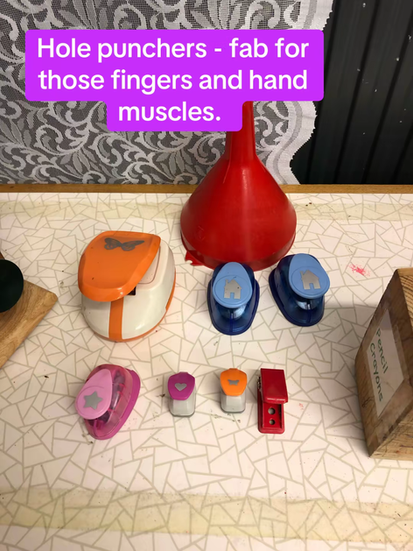Denise, You Don’t Need a Fine Motor Table!
- Mar 10
- 2 min read
Let’s talk about fine motor skills.
I see so many posts in EYFS groups asking, “What should I put on my fine motor table?” or “How do I set up a fine motor station?” And while it’s great that we’re thinking about ways to develop children’s hand strength and dexterity, let me tell you something...

Denise, you don’t need a fine motor table.
Fine motor development is happening everywhere in your classroom, all the time. You don’t need a dedicated table with tweezers, pom-poms, and nuts and bolts (unless you want one). Instead, take a look around your provision—it’s already full of opportunities for children to strengthen their little hands
Fine Motor Skills Are Built Through Play
Think about what children are naturally doing throughout the day:
Building with small blocks – Pinching, gripping, and pushing pieces together helps develop finger strength.
Threading and lacing – A great way to refine coordination and concentration.
Holding mark-making tools – Whether it’s chalk, pencils, or paintbrushes, all of it contributes to writing readiness.
Using construction toys – Connecting and pulling apart pieces builds hand strength and precision.
Manipulating small world figures – Picking up and positioning tiny people, animals, and furniture in a dollhouse works wonders for hand-eye coordination.
Dressing up and fastening clothes – Buttons, zips, and Velcro? That’s a whole hand workout right there.
Rolling, squishing, and moulding playdough – The ultimate resistance training for little fingers.
Using pegs and clips – Pegging up pictures, hanging washing in the role-play area, or attaching signs to fences builds pincer grip and control.
It’s Already Embedded in Your Classroom
You don’t need a special table for fine motor skills because it’s happening naturally in every area of your provision:
📍 The Maths Area – Picking up counters, turning number dials, stacking cubes, and using tweezers to move objects.
📍 The Writing Area – Handling clipboards, using paper clips, sharpening pencils, tearing paper, or flipping through word cards.
📍 The Role Play Corner – Pouring from jugs, holding cutlery, using tongs, buttoning up costumes.
📍 The Construction Area – Connecting, twisting, stacking, and slotting pieces into place.
📍 The Outdoor Area – Digging in the mud kitchen, fastening bike helmets, using spray bottles, collecting natural treasures like conkers and acorns.
Stop Overthinking It
The best thing you can do for fine motor development? Provide rich, varied, open-ended play and let children get on with it.
Instead of setting up a fine motor table, focus on:
Ensuring resources are accessible and inviting.
Offering a range of mark-making tools, big and small.
Encouraging play that requires gripping, pinching, twisting, and squeezing.
Letting children explore and manipulate materials freely.
So, Denise…
Take a breath. Step away from the fine motor Pinterest board. Your classroom is already doing the work for you.
Fine motor skills don’t need a table. They just need time, play, and the freedom to explore.
#FineMotorFun #EarlyYearsMagic #EYFSProvision #BuildingStrongHands #PlayToLearn #GripStrength #PencilGripPrep #EYFSTeachers #HandsOnLearning #MarkMakingMatters #StrongLittleFingers #EarlyYearsIdeas #PlayBasedLearning #LearningThroughPlay #EYFSActivities #TeacherLife
If you liked this, you might like my on deman training all about developing 'Pre Writing Skills'
that you can access here.... Take Care Mr Mc x

























Exactly this 100% no set up in my reception class 😊